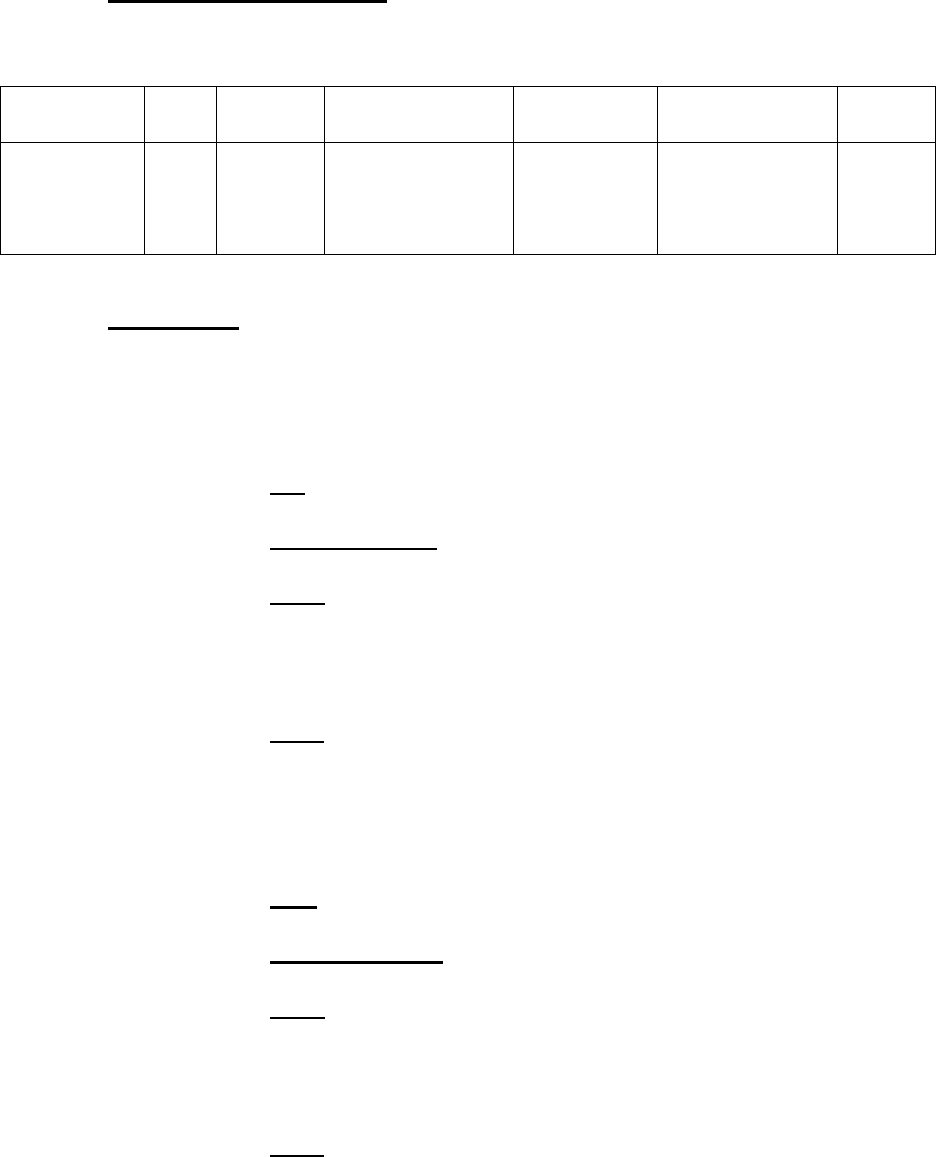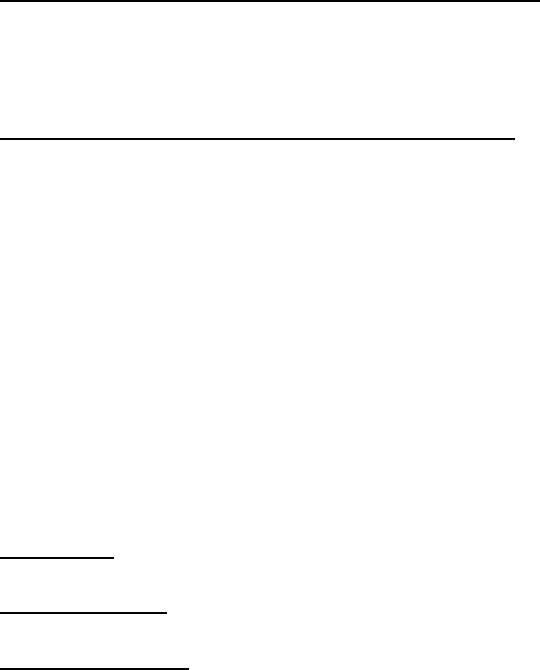
MS 1315 – WORKING CAPITAL FUND (P)
BLM MANUAL Rel. 1-797
SUPERCEDES Rel. 1-1538 10/04/2018
Form 1221-2
(June 1969)
DEPARTMENT OF THE INTERIOR
BUREAU OF LAND MANAGEMENT
MANUAL TRANSMITTAL SHEET
Release
1-797
Date
10/04/2018
Subject
1315 - WORKING CAPITAL FUND
1.
Explanation of Material Transmitted: This release transmits a revised version of BLM
Manual Section 1315, Working Capital Fund (WCF). It has been revised to include the new
programs related to WCF and to incorporate the changes to the operational procedures for
the WCF.
2.
Reports Required: None.
3.
Material Superseded: The Manual Section supersedes Rel. 1-1538
4.
Filing Instructions: File as directed below.
REMOVE INSERT
Rel. 1-1538 Rel. 1-797
27 Pages
S:/ Ann DeBlasi
Acting Assistant Director
Business, Fiscal, and Information
Resources Management
MS 1315 – WORKING CAPITAL FUND (P)
BLM MANUAL Rel. 1-797
SUPERCEDES Rel. 1-1538 10/04/2018
Contents
Chapter 1. Overview ................................................................................................................. 1-1
1.1 Purpose. ............................................................................................................................. 1-1
1.2 Objectives. ......................................................................................................................... 1-1
1.3 Authority. .......................................................................................................................... 1-1
1.4 Responsibility. ................................................................................................................... 1-1
1.5 References. ........................................................................................................................ 1-2
1.6 Policy. ................................................................................................................................ 1-3
Chapter 2 WCF Motorized and Towed Fleet (L9310) ........................................................... 2-1
2.1 WCF Motorized and Towed Fleet Overview. ................................................................ 2-1
2.2 WCF Sources of Revenue (Motorized and Towed Fleet). ............................................ 2-5
2.3 WCF Expenses (Motorized and Towed Fleet). .............................................................. 2-9
2.4 WCF Cost Coding of Financial Documents (Motorized and Towed Fleet). ............. 2-11
2.5 WCF Fleet Card Purchases. .......................................................................................... 2-12
2.6 WCF Purchase Requisitions. ......................................................................................... 2-12
2.7 Utilization Reporting Requirements............................................................................. 2-13
2.8 Bulk Fuel. ........................................................................................................................ 2-13
2.9 WCF Boats. ..................................................................................................................... 2-13
Chapter 3 WCF Stores (L9322). ............................................................................................... 3-1
3.1 Sources of Revenue and Capital Formation (Stores). ................................................... 3-1
3.2 Expenses (Stores). ............................................................................................................. 3-1
3.3 Cost Coding of Financial Documents (Stores). .............................................................. 3-2
3.4 Reporting Requirements (Stores). .................................................................................. 3-4
Chapter 4 WCF National Sign Center (L9323). ...................................................................... 4-1
4.1 Sources of Revenue and Capital Formation (National Sign Center)........................... 4-1
4.2 Expenses (National Sign Center). ................................................................................... 4-1
4.3 Cost Coding of Financial Documents (National Sign Center). .................................... 4-1
4.4 Reporting Requirements (National Sign Center). ......................................................... 4-2
Chapter 5 WCF Sign Program (L9324). .................................................................................. 5-1
5.1 Sources of Revenue and Capital Formation (Sign Program). ...................................... 5-1
5.2 Expenses (Sign Program)................................................................................................. 5-1
MS 1315 – WORKING CAPITAL FUND (P)
BLM MANUAL Rel. 1-797
SUPERCEDES Rel. 1-1538 10/04/2018
5.3. Cost Coding of Financial Documents (Sign Program). ................................................ 5-1
Chapter 6 WCF Department Forms Center (L9360). ............................................................ 6-1
6.1 Sources of Revenue and Capital Formation (Department Forms Center). ................ 6-1
6.2 Expenses (Department Forms Center). .......................................................................... 6-1
6.3 Cost Coding of Financial Documents (Department Forms Center). ........................... 6-2
6.4 Reporting Requirements (Department Forms Center). ............................................... 6-2
Chapter 7 WCF Reimbursable Program (L9390). ................................................................. 7-1

MS 1315 – WORKING CAPITAL FUND (P)
1-1
BLM MANUAL Rel. 1-797
SUPERCEDES Rel. 1-1538 10/04/2018
Chapter 1. Overview
1.1 Purpose.
This section provides information and guidance regarding the functions of the Bureau of Land
Management’s (BLM’s) Working Capital Fund (WCF).
1.2 Objectives.
The objectives of the WCF are:
A. To improve the BLM’s ability to plan and control financing, use, and replacement of
capital resources and to manage certain inventories and internal services.
B. To develop rates to be levied against benefiting BLM activities as well as external
customers in an amount approximately equal to the cost of goods or services provided.
1.3 Authority.
The Federal Land Policy and Management Act of 1976 (FLPMA), Section 306, authorized the
BLM to establish a WCF in order to supply and equip BLM programs. The initial capital of the
fund consisted of appropriations made for that purpose ($2 million) together with the fair and
reasonable value at the fund's inception of the inventories, equipment, receivables, and other
assets, less the liabilities, transferred to the fund. After the WCF was established and
operational, the original $2 million was returned to the U.S. Treasury. Additional WCF
appropriations are not anticipated. Increases in budgetary authority and assets must be derived
from WCF operations or contributions.
1.4 Responsibility.
Functional WCF responsibilities are as follows:
A. Headquarters Offices
1. The Assistant Director, Business, Fiscal and Information Resources
Management (WO800), assisted by the Deputy Assistant Director,
Business, Fiscal and Information Resources Management Business,
Fiscal, and Information Resources Management, is responsible for overall
coordination of the activities of the WCF. Responsibilities include reviewing
WCF procedures to assure conformity with the Office of Management and
Budget (OMB) and Treasury requirements, Federal Accounting and Standards
Advisory Board (FASAB) standards, and Departmental and Bureau policies
and directives; establishing policy on WCF methodology, reporting, and
accounting procedures; and applying financial expertise to management of the
WCF.
2. The Chief, Division of Budget (WO880), provides liaison for integration of
WCF into a complete Bureau program and is a conduit for OMB reports and
requirements.
3. The Chief, Division of Business Resources (WO850), provides policy
oversight for contracting, procurement, property management, and use, space
management, and for all vehicles/equipment, supplies, materials and services

MS 1315 – WORKING CAPITAL FUND (P)
1-2
BLM MANUAL Rel. 1-797
SUPERCEDES Rel. 1-1538 10/04/2018
provided through the WCF. The Division Chief assures that WCF procedures
comply with applicable Bureau, Department, and Federal Property
Management regulations. The Division Chief also issues directives, when
necessary, to supplement existing directives in the Administrative Services
area in connection with WCF operations.
B. National Operations Center (NOC)
1. The WCF Manager (OC612) is responsible for the financial operations of
the WCF, which includes developing financial and related procedures,
preparing budgets and projections, establishing class based WCF rates,
determining the availability of funds for purchases by the WCF, developing
and preparing current operating reports, making cost estimates, acting as
financial advisor on WCF matters, and monitoring the liquidity of the WCF
funds. The WCF Manager assists the Division of Budget in budget
preparation.
2. The Chief, National Property and Support Branch (OC650), provides
overall property management services for all property in the WCF. This
includes maintaining centralized property records and providing counsel and
assistance in the acquisition, use, and disposal of WCF property, including
vehicles, equipment, stores inventories, Sign Center materials, and forms and
publications inventories. The Branch Chief is responsible for classifying
vehicles/equipment, establishing and maintaining property replacement
schedules, estimating useful life of property, setting utilization standards,
supplying information to the WCF Manager for use in setting fixed ownership
and Use Rates, scheduling inventories, preparing WCF property reports,
initiating purchase of replacement items for some classes of property, and
developing property management procedures and directives in connection
with WCF property management.
C. All Employees involved in the management of WCF programs and use of WCF
vehicles/equipment are responsible for knowing and following the guidelines and
instructions contained in this Manual Section.
1.5 References.
A. FLPMA
B. Handbook 1525-1 Fleet Management
C. Manual Section 1525- Fleet Management
D. Interior Property Management Directives 410 Addition to IPMD. Accountability—
Subpart 114-60.201-2 – Capitalization Threshold
MS 1315 – WORKING CAPITAL FUND (P)
1-3
BLM MANUAL Rel. 1-797
SUPERCEDES Rel. 1-1538 10/04/2018
1.6 Policy.
A. The BLM’s WCF is established to finance and account for services and goods
furnished to the Bureau's various benefiting activities as well as non-BLM customers.
Amounts expended or to be expended by the WCF are funded by user rates or
donations from other funds to ensure that adequate funds are available to support
authorized Bureau and other customer programs.
B. The WCF encompasses six distinct programs as follows:
1. WCF Motorized and Towed Fleet (L9310)
2. WCF Stores (L9322)
3. WCF National Sign Center (L9323)
4. WCF Sign Program (L9324)
5. WCF Department Forms Center (L9360)
6. WCF Reimbursable Program (L9390)
Any expansion or contraction of the number of programs requires a change in
BLM policy.
C. The BLM WCF Committee is an advisory board comprised of six members as
follows:
A. Deputy Assistant Director of Business, Fiscal and Information Resources
Management (W0800).
B. Two State Office Representatives selected by the Business Management
Council (BMC)
C. National Fire Equipment Program Representative selected by National
Interagency Fire Center Management (NIFC)
D. National Fleet Manager (OC650)
E. WCF Manager (OC612)
D. The committee functions in the capacity of reviewing any major policy considerations
which affect the BLM’s WCF and is chaired by the Deputy Assistant Director,
Business, Fiscal, and Information Resources Management. The committee acts as a
recommending unit only, and all final policy decisions must be approved by the
Assistant Director, Business, Fiscal, and Information Resources Management
(W0800).

MS 1315 – WORKING CAPITAL FUND (P)
2-1
BLM MANUAL Rel. 1-797
SUPERCEDES Rel. 1-1538 10/04/2018
Chapter 2 WCF Motorized and Towed Fleet (L9310)
2.1 WCF Motorized and Towed Fleet Overview.
WCF Motorized and Towed Fleet – Functional Area L9310 - is managed at the NOC. The WCF
Fleet program allows for the replacement, operations, maintenance, and repairs of BLM-owned
vehicles/equipment. Fixed Ownership Rate (FOR) and Use Rate assessments are collected to
fund these objectives. The WCF Manager is responsible for rate-setting to ensure adequate
collections. The WCF Fleet is comprised of capitalized vehicles/equipment with exception of
the items listed in .11.B (Excluded Vehicles/Equipment). WCF Fleet may at times include
betterments (or sub-assets) that fall below the capital threshold.
A. WCF Fleet Vehicle/Equipment Classes. WCF Fleet is categorized in seven major
groups of classes as illustrated in the following table:
Class Group
Work Breakdown Structure Range
(1) General Purpose Vehicles
LW.MV.01000000 to
LW.MV.01990000
(2) Special Purpose Vehicles
LW.MV.03000000 to
LW.MV.03990000
(3) Miscellaneous Equipment
LW.MV.04000000 to
LW.MV.04990000
(4) Wildland Fire Equipment
LW.MV.06000000 to
LW.MV.06990000
(5) Oregon Heavy Equipment
LW.MV.07000000 to
LW.MV.07990000
(6) Motor Equipment, Heavy Duty
Construction, and Miscellaneous
LW.MV.08000000 to
LW.MV.08990000
(7) Seed Drills
LW.MV.09000000 to
LW.MV.09990000
Note: Classes and Work Breakdown Structure are used synonymously throughout this
document.
1. General Purpose Vehicles. General Purpose Vehicles include any licensed,
motorized vehicle used primarily for transportation of people or property and
driven on highways. No underutilization is charged on general purpose
vehicles. General Purpose replacement standards are based on miles/hours
and years of use are not considered.
2. Special Purpose Vehicles. Special Purpose Vehicles are determined to have
a time-limited mission need and will not be replaced. Since these
vehicles/equipment will not be replaced, there are no FOR assessments
charged on special purpose vehicles. Use Rate assessments are still charged
on special purpose equipment to cover limited maintenance items. Under no
circumstances are repairs of Special Purpose Vehicles/equipment authorized
to be funded by the WCF regardless of negligence. See Fleet Management
Manual 1525 for additional guidance concerning Special Purpose
vehicles/equipment.
MS 1315 – WORKING CAPITAL FUND (P)
2-2
BLM MANUAL Rel. 1-797
SUPERCEDES Rel. 1-1538 10/04/2018
Class 399 vehicles, which are part of the Special Purpose Vehicles/equipment
group, are in the WCF for reporting purposes only and are not charged either a
Use Rate assessment or a FOR assessment. As such class 399 vehicles cannot
charge any costs against the WCF. No fleet cards will be issued to class 399
vehicles/equipment.
3. Miscellaneous Equipment. Miscellaneous equipment includes equipment
not covered by any other class of vehicles/equipment such as skid-steers,
forklifts, and snow tractors. Miscellaneous Equipment items are charged an
underutilization assessment annually if they do not meet the established
annual utilization standard. Underutilization will be charged against the
standard cost structure associated with the piece of equipment or vehicle.
Replacement standards are based on both utilization units as well as years of
use.
4. Wildland Fire Equipment. Wildland Fire Equipment includes any
vehicles/equipment that are outfitted with fire lights, stripes, and/or sirens.
This class of equipment includes Command Vehicles, Type 3 Engines, Type 4
Engines, Type 6 Engines, Water Tenders, Remote Automated Weather Station
(RAWS) Vehicles, and Fire Boats. Fire equipment FOR and Use Rate costs
are charged against fire projects in which the equipment is used using
exception cost structure(s). If the equipment is not used in connection with
fire activity, then the use shall be charged against a non-suppression related
cost structure.
Due to the unpredictability of fire seasons, underutilization is not charged on
fire equipment. Fire equipment replacement standards are based on miles or
hours of operation with no consideration of years except when extenuating
circumstances require early replacement partially funded by a contribution.
5. Oregon Heavy Equipment. Due to the number of pieces of heavy equipment
in the Oregon heavy equipment fleet, these items are managed separately from
all other heavy equipment. Oregon Heavy Equipment includes construction
equipment, materials handling equipment, and other mobile equipment used to
maintain existing infrastructure in Oregon.
Oregon Heavy Equipment is financially managed at the state balance level.
Financial management data is sent monthly by the NOC to the Oregon Heavy
Equipment Committee. Oregon’s Heavy Equipment Committee evaluates the
current and future need of Oregon and determines the make-up of its fleet and
if like-for-like replacements are necessary or if new types of equipment are
needed.
For additional guidance on Oregon Heavy Equipment, see the Heavy
Equipment section (.11.A.6).
MS 1315 – WORKING CAPITAL FUND (P)
2-3
BLM MANUAL Rel. 1-797
SUPERCEDES Rel. 1-1538 10/04/2018
6. Motor Equipment, Heavy Duty Construction, and Miscellaneous. State
Heavy Equipment Committees are established and chartered by State
Directors to promote the efficient and cost-effective use of all heavy
equipment within their respective states. WCF heavy equipment classes are
managed at the BLM organizational state balance level.
Periodically NOC WCF Accountants send each state, either the State Engineer
or the State Heavy Equipment committee representative, its Heavy Equipment
State Balance report. The Heavy Equipment State Balance report, when
properly used as a decision-making tool, is a key component of the state’s
management of its fleet and fund availability balance. The report includes
both the available state balance (including all collections and expenditures)
and the amount of FOR revenue collected on all active equipment.
State Heavy Equipment Committees or State Engineers evaluate the current
and future heavy equipment needs of their state and determine if an identical
or similar replacement is necessary or if new types of equipment are needed to
accomplish changing program objectives within their state. As purchase
needs are identified, the states initiate their purchase requisitions.
All heavy equipment acquisition purchase requisitions must be approved by
the state’s Heavy Equipment Committee or the State Engineer and be
electronically documented in the Financial and Business Management System
(FBMS). Acceptable forms of approval may be either (1) the electronic
approval of the FBMS Purchase Requisition, or (2) the electronic attachment
to the FBMS Purchase Requisition of a signed approval by the Committee’s
representative or state engineer. Additional Purchase Request approvals must
be granted by both the National Fleet Manager and the WCF Manager. Heavy
equipment Purchase Requisitions not meeting the aforementioned approval
requirements are rejected at the NOC until met.
Depending on the planned equipment needs of a state, and how much that
state expects to spend on equipment in relationship to its State Heavy
Equipment balance, and provided the National Fleet Manager gives approval,
WCF funding may be certified to purchase new augmentations to the fleet or
replacement equipment. The WCF Manager certifies these funds based on
various factors including, but not limited to, the adequacy of available balance
for immediate needs and the adequacy of expected cash balances for future
needs. Under certain circumstances (such as the purchase of nonstandard,
optional equipment, upgrades, downgrades, etc.), a state may be required to
contribute additional funding before a purchase request is certified, or an
allowance may be made. The funding decision ultimately rests with the WCF
Manager.
Sometimes the best use of a state’s available balance and the management of
its asset portfolio may be to share assets across offices and districts, or even,
to transfer assets to other states or downsize altogether. Depending on the

MS 1315 – WORKING CAPITAL FUND (P)
2-4
BLM MANUAL Rel. 1-797
SUPERCEDES Rel. 1-1538 10/04/2018
decision or transaction, there could be a financial impact with respect to the
state’s available balance (for instance, transfers out from one state to another
could mean a decrease in the available balance in one state and an increase in
available balance in another’s due to the transfer of any associated FOR
assessment).
In any case, heavy equipment decisions – whether at the State Heavy
Equipment Committee level, the NOC level, or otherwise, must be made in a
manner that promotes the efficient and cost-effective use of all heavy
equipment within the bureau and complies with applicable bureau policy.
7. Seed Drills. Seed Drills consist of both 3-cart and single-cart drills. The
drills are used in the stabilization and restoration of areas affected by wildland
fires. FOR and Use Rates are charged on a per-acre drilled basis. There is no
under-utilization assessment on drills. While drills must report usage, Drill-
Carts are not utilization-relevant.
Drill maintenance is performed at the Drill Shop located in Vale, OR. Drill
Shop maintenance is charged to the WCF and expenses are recouped through
Use Rate assessment.
B. Excluded Vehicles/Equipment. Subject to review by the National Fleet Manager,
certain exceptions to the capitalized vehicles/equipment requirement may exist.
Additional vehicles/equipment may be excluded at the discretion of the National Fleet
Manager in conjunction with the WCF Manager. Any Non-WCF vehicles/equipment
bought without the review and approval of the BLM Fleet Team at the NOC will be
reviewed by property/ acquisition for further action.
Whenever an asset is excluded from the WCF yet meets the capital threshold, DOI
and Bureau policy dictate it must still be capitalized. This capitalization occurs
outside the WCF.
C. Holdover Vehicles/Equipment. Holdover vehicles/equipment are
vehicles/equipment that have been replaced, have not yet been disposed of, and are
still available for use. Holdover vehicles/equipment are not subject to
underutilization charges. All costs charged to the WCF for hold-over
vehicles/equipment are reviewed monthly and determination is made if the cost is an
authorized WCF charge or if the cost needs to be reallocated to the benefitting
activity.
The fixed ownership rate (FOR) assessment will continue to be charged on holdover
vehicles/equipment. As vehicles/equipment are continued to be used, the estimated
salvage value of the vehicle/equipment is reduced. The continued assessment of FOR
is meant to offset the reduced expected salvage value.

MS 1315 – WORKING CAPITAL FUND (P)
2-5
BLM MANUAL Rel. 1-797
SUPERCEDES Rel. 1-1538 10/04/2018
See Fleet Management, H-1525-1 for additional information about holdover
vehicles/equipment.
2.2 WCF Sources of Revenue (Motorized and Towed Fleet).
Since the WCF does not receive an annual appropriation, the operation of the WCF Fleet
program primarily relies on revenue from the assessment of user fees. The fees are charged
against the benefiting activity for the use of vehicles/equipment.
A. Vehicle/Equipment Use Rate. The Use Rate assessment is the cost charged against
a benefitting activity for the program using the WCF vehicle/equipment. The
assessments are charged monthly based on the number of miles, hours, or acres the
vehicle/equipment is used multiplied by the class-wide Use Rate. The Use Rate
assessment is used to cover the operating costs of the fleet. The rates are set at a level
that covers fuel and allows for WCF vehicles/vehicles/equipment to be maintained in
a safe operating condition. For Special Purpose classes, see section (.11.A.2).
Preventative care not only helps keep vehicles/equipment safe, but it also reduces
downtime, extends their life, and increases sales proceeds. Funds received by the
WCF through the assessment of Use Rates are used to pay for routine repairs and
maintenance not deemed to be caused by abuse, neglect, human caused damage with
or without intent, Acts of God, or nature (weather, animals, etc.). State-specific
expenses such as emission requirements are not covered by the WCF. See H-1525-1
for guidance related to non-allowable repairs. Use Rate revenue is never used to pay
for the acquisition of equipment. Overhead cost associated with managing the WCF
are also incorporated into Use Rates. Overhead consists of personnel costs for the
WCF Manager and Accountants, NOC Fleet staff, and certain NIFC Fire Equipment
Specialists. Other individuals may charge time to the WCF if authorized by the WCF
Manager.
The Use Rate assessment is charged monthly to vehicles/equipment based on the
amount of usage the vehicles/equipment reported during the monthly utilization
reporting window. The Use Rate assessment can be based on hours, miles, or acres of
use. Use Rate Revenue is coded to commitment item WMRUI0 in the accounting
system (currently the Financial and Business System, or FBMS).
All vehicles/equipment in FBMS are assigned a standard cost structure(s) to which all
utilization charges incurred are charged against on a percentage basis unless a field
office enters an exception cost center(s). Multiple exception cost centers may be
entered during the utilization reporting window on a reporting unit basis. If exception
cost centers reporting units do not sum to the total reported utilization for the month,
the remaining reporting units are charged to the standard cost structure(s).
WCF Finance personnel recalculate Use Rates for each vehicle class every fiscal year
or as necessary based on actual vehicle use expenses compared with actual use
revenues from previous fiscal year(s), the objective being for each vehicle class to
break even over its cumulative inception-to-date life. These rates may be viewed in
FBMS table ZUSE_RATE.

MS 1315 – WORKING CAPITAL FUND (P)
2-6
BLM MANUAL Rel. 1-797
SUPERCEDES Rel. 1-1538 10/04/2018
B. Vehicle/Equipment Fixed Ownership Rate (FOR). The FOR assessment is the
cost charged against a benefitting activity for the program using the WCF
vehicle/equipment. The FOR assessment is used to collect sufficient funds for the
eventual replacement of the vehicle/equipment being charged the FOR assessment,
including all costs associated with the acquisition of the asset (e.g., shipping and
taxes).
The FOR assessment is charged monthly to vehicles/equipment based on the amount
of usage the vehicles/equipment reported during the monthly utilization reporting
window. FOR can be based on hours, miles, or acres of use. FOR revenue is coded
to commitment item WMRFI0 in the accounting system.
All vehicles/equipment in FBMS are assigned a standard cost structure(s) to which all
FOR assessments are charged against on a percentage basis unless a field office
enters an exception cost center(s). Multiple exception cost centers may be entered
during the utilization reporting window on a reporting unit basis. If exception cost
centers reporting units do not sum to the total reported utilization for the month, the
remaining reporting units are charged to the standard cost structure(s). Additional
FOR revenue is received by the WCF from an underutilization charge assessment on
equipment that takes place annually in September or whenever the equipment is
transferred/disposed. The purpose of the assessment is to collect enough revenue to
pay for equipment replacement. The assessment is used as a tool to ensure sufficient
funds are available to cover the cost of replacements when specific equipment has
met the age replacement standard but not the miles/hours replacement standard.
Equipment units that are underutilized are charged for the difference between the
minimum utilization and the actual utilization for each fiscal year at the end of the
year or a prorated amount if the equipment unit transferred to a different office or
disposed of during the year, with the result multiplied by the FOR unit cost.
Fire-fighting equipment in classes 0611 through 0689 (Work Breakdown Structures
LWMV06110000 through LWMV06890000) as well as general purpose classes are
not charged underutilization assessments.
The FBMS Utilization Status Report tracks under-utilization from the beginning of
the fiscal year. This report is then sent to field office managers during the 3
rd
and 4
th
quarter. This report projects potential under-utilization charges that will post in
September after the normal utilization charges have posted. The Utilization Status
Report is intended to alert managers and/or budget analysts of charges that may be
incurred in September.
WCF Finance personnel set the FOR rates annually or as necessary based on the
following factors: the annually adjusted estimated vehicle/equipment replacement
cost, expected inflation, salvage value, and estimated useful life (years and
miles/hours). The determined rate is charged over the estimated useful life of the
vehicle/equipment based on reported usage. FOR charges are levied against the
standard cost structure associated with the vehicle/equipment unless an exception cost

MS 1315 – WORKING CAPITAL FUND (P)
2-7
BLM MANUAL Rel. 1-797
SUPERCEDES Rel. 1-1538 10/04/2018
structure is reported. The cumulative revenue collected from the FOR assessment on
a vehicle/equipment stays with the vehicle/equipment throughout the life of the
vehicle/equipment regardless of the office to which the vehicle/equipment is initially
assigned. These rates may be viewed in FBMS table ZUSE_RATE.
Whenever a vehicle in an FOR-paying class is not replaced or residual funds exist
after replacement occurs, FOR funds paid into the WCF remain in the WCF. These
funds are available for use by the States for future acquisitions. The WCF tracks
these funds by the state that possessed the vehicle/equipment at date of disposal.
These funds are available to use in lieu of a contribution. For policy on contribution
requirements see section .12F below.
C. Vehicle/Equipment Donations. Before any capitalized asset can be replaced by the
WCF, it must first be donated to the fund. Any used equipment donation must have a
thorough inspection prior to being donated to the WCF. The cost of the inspection
plus any necessary repairs to ensure that the vehicle is safe working condition must be
paid for by non-WCF funds. All used equipment donations will be classified as
special purpose vehicles/equipment.
D. Sales Proceeds from the Sale of WCF Assets. The WCF has statutory authority
under FLPMA to retain income derived from the sale of WCF assets. The proceeds
received are used to cover part of the acquisition cost of the replacement
vehicle/equipment. Estimated sales proceeds are compared to actual proceeds
received. If a buyout contribution was received, excess contribution proceeds will be
returned to the office that made the contribution or if the actual proceeds were less
than expected, an additional contribution may be required.
Disposal of Vehicles/Equipment – All vehicles/equipment must be disposed of using
the General Services Administration (GSA) disposal process. The NOC (OC653) is
the only authorized entity for managing the disposal of vehicles/equipment. For
details on the disposal process see MS 1520- Personal Property Management.
Trade-ins of vehicles/equipment - In certain circumstances, a trade-in of a vehicle or
equipment is authorized as a means of disposal. Trade-ins are authorized when the
economic benefit of trading in the vehicle/equipment is greater than the economic
benefit of disposing the vehicle through GSA. All trade-in contracts must adhere to
all contracting requirements. All trade-ins must be approved by OC653. Reductions
in the acquisition cost, given due to the trade-in of a vehicle/equipment, are treated as
salvage proceeds of the vehicle/equipment being traded-in. The NOC creates
additional FBMS entries in order to properly record the acquisition cost of the
acquired vehicle.
Sales proceeds (salvage) received on the disposition of all vehicles/equipment not
being replaced are deposited to the miscellaneous receipts fund of the U.S. Treasury
as the WCF is not authorized to retain these sales proceeds. This would include all or
most Special Purpose vehicles/equipment.

MS 1315 – WORKING CAPITAL FUND (P)
2-8
BLM MANUAL Rel. 1-797
SUPERCEDES Rel. 1-1538 10/04/2018
E. Insurance Proceeds from Accident Damage. All reimbursement checks for
accident damage to WCF vehicles/equipment paying a Use Rate must be sent to the
NOC (OC621). The check must be submitted along with the Collection and Billings
System (CBS) system-generated Collection Transmittal, Form 1370-8. The sender
must notate in the text field of Form 1370-8 the WCF vehicle license number and
Standing Work Order (ST01) and Maintenance Work Order (ME01). Payments for
repairable damage are posted as Use Rate Revenue and are coded to Commitment
Item WMRUI0 in FBMS. Proceeds received from the disposition of wrecked
vehicle/equipment deemed a total loss, by a report of survey, are posted as sales
proceeds and are coded to Commitment Item WORVS0.
F. Contributions. Contributions are funds transferred into the WCF at the direction of
and communicated by WCF Finance in order to provide necessary funding for
acquisitions when current WCF funds are not sufficient. The benefitting activity
ordering the asset completes Form 1510-18v and submits it to the NOC Fleet
Manager (OC653) who, in turn, processes the document and delivers it to the NOC
WCF Accountant (OC612) who processes the FBMS contribution document.
Contributions can be classified as a new purchase, betterment, non-standard options,
or early buyout contribution. Contributions are estimates and are refunded if the
contribution made into the WCF is greater than what was actually needed.
Conversely, if the estimated contribution ends up being less than what was actually
needed, then an additional contribution is required.
1. New Purchase Contributions. New Purchase contributions are deposited
into the WCF if an office needs a vehicle or piece of equipment that is an
addition to the WCF fleet that does not replace a current WCF
vehicle/equipment
2. Betterment Contributions. Betterments are assets that cannot stand alone
and are an addition to the base vehicle/equipment. Betterment contributions
to the WCF are necessary to authorize the WCF procurement as well as
document the added value of the equipment.
3. Non-Standard Options Contributions. Non-Standard Option contributions
are deposited into the WCF when an office is purchasing a vehicle/equipment
that includes options not covered by the FOR (e.g., backup cameras). For a
list of options covered by the WCF refer to BLM Fleet Manual 1525.
4. Early Buyout Contributions. Early Buyout contributions are required to be
deposited into the WCF if a vehicle/equipment is being replaced before
reaching its estimated useful life. The WCF Finance team will determine the
early buyout contribution required.

MS 1315 – WORKING CAPITAL FUND (P)
2-9
BLM MANUAL Rel. 1-797
SUPERCEDES Rel. 1-1538 10/04/2018
5. Other. Contributions may be required in other circumstances (e.g., a
contribution deposited into a state Heavy Equipment balance to make up for
known shortages.)
2.3 WCF Expenses (Motorized and Towed Fleet).
Personnel using Bureau-owned vehicles/equipment against which Use Rates are charged
must code the operation, maintenance, and repair costs of this equipment to the WBS of the
equipment being utilized.
A. Operations, Maintenance and Repair Costs.
1. Equipment Operation Costs. Equipment operation costs consist of fuel) and
oil. All purchases of fuel for consumption by Bureau-owned vehicles that pay
Use Rates are charged to the WCF.
2. Maintenance Costs (Preventative). Maintenance costs are those incurred to
keep Bureau-owned vehicles/equipment covered by Use Rates under the WCF
in a safe, serviceable condition. Preventative maintenance not only keeps
vehicles/equipment safe, but it also reduces downtime and increases sales
proceeds. See H-1525-1 for a list of covered preventative maintenance costs.
Offices with approved maintenance shops can charge mechanic wages to the
WCF for the time spent working on BLM-owned vehicles/equipment.
Approval must be obtained from WO800 to establish a motor vehicle
maintenance shop before mechanics employed there may charge their time to
the WCF for maintenance or repair work on BLM-owned vehicles/equipment.
3. Holdover Costs. Only fuel, windshield repair at time of disposal, oil changes,
reasonable disposal detailing expenses, and final inspection costs are paid by
the WCF for holdovers. Other holdover charges must be coded directly to the
benefiting activity. On a monthly basis, the NOC (OC612) reviews all
holdover charges ensuring all charges are authorized to be funded by the
WCF. If charges are deemed not be authorized for WCF funding, then the
field must reallocate the charges.
4. Repair Costs. Repair costs are those that are incurred to maintain the specific
WCF Fleet item of in safe efficient operating condition through the restoration
or replacement of parts, components, or assemblies of Bureau-owned
vehicles/equipment as necessitated by wear and tear, or the failure of parts.
All repair costs that meet the above criteria are charged to the WCF if the
vehicle/equipment is charged a Use Rate. WCF disallows repair costs
resulting from abuse, neglect, human-caused damage with or without intent,
Acts of God, or nature (weather, animals, etc.). Any receipts payable to the
WCF for Reports of Survey, other than total-loss incidents, are credited
against the repair costs associated with the report. If a warranty is still in
effect for the vehicle/equipment being repaired, the warranty must be used.

MS 1315 – WORKING CAPITAL FUND (P)
2-10
BLM MANUAL Rel. 1-797
SUPERCEDES Rel. 1-1538 10/04/2018
See H-1525-1 for guidance concerning repairs not authorized to be charged to
the WCF.
5. Accident Damage. All unreimbursed repair costs for accident damage must
be charged to the benefitting activity from the using office and not to the
WCF. If a vehicle is totaled in an accident, and it is in a class that pays an
FOR fee, part of the replacement cost for a new vehicle will come from the
WCF. The remainder of the replacement cost must come from the benefitting
activity from the using office. The proportion that the WCF contributes
toward the replacement cost is equal to the dollar amount of FOR revenue
already charged against the demolished vehicle, plus the estimated proceeds
from the sale of the vehicle. Unless other arrangements are made with the
WCF Manager, if the using office does not desire a replacement, it must still
reimburse the WCF for the difference between the amount of FOR revenue
paid plus the salvage value, and the cost of a new replacement, which will be
issued to another BLM office expressing a need. See H-1525-1 for
documentation requirements related to accidents.
6. Vehicle Options Not Paid For by WCF. Certain add-ons and modifications
to vehicles/equipment which are not standard options will not be paid for by
the WCF. Costs of this nature must be paid by the benefiting activities by
making a deposit into the WCF. See H-1525-1 for more information about
not standard options.
B. Vehicle Replacement. BLM vehicles which meet replacement standards must be
replaced.
1. Useful Life Standards. Generally, all bureau-owned vehicles/equipment
charged the FOR assessment are replaced with monies from the WCF. The
normal criteria for vehicle/equipment replacement are based on age or the
number of miles driven or hours used. The replacement standards are applied
on a vehicle class-wide basis. Earlier replacement due to excessive repair and
maintenance costs will be considered on a case-by-case basis. The
replacement standards for specific classes of vehicles/equipment are found in
the FBMS utilization rate table (ZUSE_RATE). An extraction of the rate
table is emailed annually by the NOC (OC612) to the BLM fleet management
community during the first quarter of each fiscal year. The table displays the
recommended replacement years and the annual minimum use standards.
2. Vehicle/Equipment Replacements. The procedures for ordering WCF
replacement vehicles/equipment may be found in BLM Handbook H-1525-1.
The National Fleet Manager (OC653) is responsible for the development and
coordination of the replacement plan. WCF Finance (OC612) determines
fund availability and must certify funds for all obligations incurred for the
purpose of replacing WCF vehicles and equipment. If a vehicle is to be

MS 1315 – WORKING CAPITAL FUND (P)
2-11
BLM MANUAL Rel. 1-797
SUPERCEDES Rel. 1-1538 10/04/2018
disposed without replacement, then a 1525-11 form must be submitted to the
National Property Fleet Section (OC653)
2.4 WCF Cost Coding of Financial Documents (Motorized and Towed Fleet).
All financial documents, e.g., requisitions, oral orders, purchase orders and contracts relating to
the operation of the Bureau's Motorized and Towed Fleet must be coded in FBMS as follows:
A. Fund Code. XXXL4525RV (WCF) (Revolving Fund)
B. Functional Area. L93100000.* - WCF Motorized and Towed Fleet
C. Program Element.
1. Fleet Operations and Maintenance. 120000
2. Fleet Capital Acquisitions (Must use Commitment Item 311*). 130000
3. Fleet Charges (Bulk Fuel only). 140000
D. Work Breakdown Structure (WBS). (LW.MV.0*) All financial transactions
involving functional area L9310 must be coded with a twelve-digit project number.
The first digit of the eight-digit project code is always zero. The next three digits of
the code are normally the vehicle class number(s) for which the transaction was
initiated. The last four digits of the code are zeros (e.g., LW.MV.0XXX0000.).
There are two categories of project numbers which do not reflect vehicle classes: The
first category is the LWMV06000000-LWMV06050000 classes which pertain to
National Interagency Fire Center (NIFC) fire administrative charges. These numbers
are assigned to specific financial transactions by NIFC. The second category is
utilized for financial transactions for which a particular vehicle class(es) cannot be
identified, even by estimating. Non-identifiable financial transactions for the Oregon
Heavy Equipment program should be charged to project number LWMV07000000
for Administrative, LWMV07100000 for Bulk Fuel, and LWMV07110000 –
LWMV07320000 for specified maintenance and indirect costs. All other non-
identifiable project number financial transactions should be charged to project
number LWMV05000000 Administrative, LWMV05100000 Bulk Fuel, and
LWMV05200000 – LWMV05210000 for maintenance shop overhead. Projects
LWMV05000000 and LWMV07000000 must never be viewed as "catch all"'
accounts for WCF costs. No project number other than a valid vehicle class and those
specifically identified above may be used except by approval of the WCF Manager.
E. Work Order. System-generated, 8-character, numeric value associated with either
the Standing Work Order (ST01) or Maintenance Work Order (ME01) of the
equipment. This value is required when using Functional Area L93100000.120000,
and it derives the values for Fund, Functional Area, and WBS.

MS 1315 – WORKING CAPITAL FUND (P)
2-12
BLM MANUAL Rel. 1-797
SUPERCEDES Rel. 1-1538 10/04/2018
F. Funds Center. LL* (use appropriate funds center)
G. Commitment Item. Commitment items are used to classify similar expenses in a
category. All expenses incurred by the Working Capital Fund must have a
commitment item. Commitment item is the FBMS term for the U.S. Treasury term
“budget object class (BOC).”
2.5 WCF Fleet Card Purchases.
A Fleet charge card is issued with each WCF vehicle or piece of equipment. The Fleet card is to
be used for authorized WCF fuel, maintenance, and repairs up to the fleet charge card limit. Any
unauthorized charges made on a Fleet card must be reallocated to the benefitting activity. There
is to be no fueling of motorcycles, UTV’s, snow-blowers, lawn mowers, etc., using BLM Fleet
cards. Fleet cards have an associated standing work order (STO1). The default cost center in the
standing work order must be the same as the default cost center on the associated asset’s
Equipment Master Record. This helps ensure that fleet costs post to the same cost center as any
associated revenue from utilization postings. For additional details on Fleet charge cards, see
BLM Manual 1512.
2.6 WCF Purchase Requisitions.
Purchase Requisitions (PRs) are required for WCF maintenance/repair charges over the fleet card
limit and for acquisitions of WCF Fleet Asset acquisitions, described as follows:
A. Maintenance/Repairs. Maintenance/Repair charges to the WCF over fleet card limit
amount will require a PR. All PRs charging the WCF fund must be fleet- or ad-hoc
approved by the National Operations Center Fleet Property Section (OC653).
Maintenance PRs may be multi-funded. Determination of funding of Maintenance
PRs is made by the ad-hoc or fleet approver. Exceptions for Oregon Heavy
Equipment and Fire Vehicles/equipment Maintenance/Repairs exist, as follows:
1. Oregon Heavy Equipment Maintenance/Repairs. Purchase Requisitions
are approved by the head of the Oregon Heavy Equipment Committee
Chairs. The Oregon Heavy Equipment Chairs must adhere to the same
standards of review that all BLM fleet is subject to, ensuring that only
authorized WCF expenses are approved.
2. Fire Vehicle/Equipment Maintenance/Repairs. The NIFC is authorized to
approve maintenance and repairs PRs under $10,000. The NIFC must adhere
to the same standards of review that all BLM fleet is subject to, ensuring that
only authorized WCF expenses are approved. For Maintenance and repairs
greater than $10,000 but less than $15,000, the NIFC must consult the OC653
prior to approval. For expenses greater than $15,000, OC653 is the only
authorized approver.
B. Acquisitions. All Acquisitions of WCF fleet assets with the exception of fire
equipment in the LWMV06* WBS series must be approved by OC653. All
Acquisitions of WCF fire equipment must be approved by the National Fire
MS 1315 – WORKING CAPITAL FUND (P)
2-13
BLM MANUAL Rel. 1-797
SUPERCEDES Rel. 1-1538 10/04/2018
Equipment Program (NFEP) Manager. Only WCF funds are authorized to purchase
vehicles/equipment. If funds other than WCF funds are needed for the acquisition,
they must first be contributed to the WCF and then the WCF funding will pay for the
acquisition. Finally, due to safety and other full lifecycle management requirements
of a federal revolving fund, WCF acquisitions of vehicles/equipment are strictly
limited to new equipment, thereby precluding the purchase of used equipment.
2.7 Utilization Reporting Requirements.
BLM vehicles/equipment utilization must be reported every month, even if utilization for the
month is equal to zero, for all utilization-relevant classes. Utilization must be reported through
the Financial and Business Management System (FBMS) Monthly Utilization Reporting Screen
for each WCF and GSA-owned vehicle/equipment. Utilization is reported in hours, miles, or
acres depending on the class of vehicle/equipment. Use Rate and FOR assessments will be
charged against the standard cost structure(s) associated with the vehicle/equipment reporting
utilization unless an exception cost structure is entered. GSA vehicles are charged a flat monthly
rate plus a mileage rate.
2.8 Bulk Fuel.
Several field offices throughout the BLM have bulk fuel tanks. Bulk fuel tanks are intended to
be in locations where fuel stations are not readily accessible. Bulk fuel tanks are only authorized
to provide fuel to WCF vehicles/equipment subject to a Use Rate fee. All bulk fuel tank activity
must be reported on the Fuel and Oil Issue Record (Form 1520-28). A monthly reconciliation
must be performed and reported on the Fuel Reconciliation Record (Form 1520-28a). The two
forms must be sent to the National Operations Center (OC612) each month. Acquisition of fuel
to fill the bulk fuel tank must be done through the PR process, or in some instances purchase
card. When individual vehicles receive bulk fuel the number of gallons and cost must be entered
in the Fuel Acquisition Quantities area of the FBMS Monthly Utilization Screen.
2.9 WCF Boats.
All boats $50,000 and higher in acquisition cost are placed in the WCF, Functional Area L9310*,
WBS LWMV*. Capitalized boats that meet the aforementioned threshold are considered WCF
equipment. FOR is charged in order to pay for the replacement of the boat (shell only, except in
the case of fire boats, a shell and pump).
WCF boat-trailers are capitalized under separate WCF classes and collect their own FOR. Non-
cap boat-trailers, whether controlled or uncontrolled – are considered non-WCF equipment.
Both operations (gasoline, oil, etc.) and maintenance (O&M) and repairs are covered in
establishing use rates. Whenever it is necessary – and pending the structure of the use rate for a
given boat class -- midlife engine replacements may be covered in use rates as well. A fleet card
is issued for O&M and repairs. Engine replacements follow the normal purchasing process
(requisition, obligation, etc.).
BLM Fleet Management Team at the NOC provides property management for boats including
safety, plating, maintenance (including engine replacements), etc.

MS 1315 – WORKING CAPITAL FUND (P)
3-1
BLM MANUAL Rel. 1-797
SUPERCEDES Rel. 1-1538 10/04/2018
Chapter 3 WCF Stores (L9322).
The WCF Stores program is comprised of materials and supplies acquired and stored for
subsequent issue to projects or using activities. Stores are consumed, lose their identity, or
become an integral part of other property when put in use. Currently the authorized stores
programs are seed inventory handled at the warehouses in Boise, Idaho and Ely, Nevada.
Commercially-made signs are handled at the warehouse at the NOC.
3.1 Sources of Revenue and Capital Formation (Stores).
The WCF Stores program must recover revenue in an amount approximately equal to the cost of
stores purchased, operating expenses, administrative overhead costs, write-offs and inventory
losses, and transfers of excess inventory without reimbursement.
A. Stores Issue Revenue. When stores are issued, the benefiting activity must
reimburse the WCF for the cost of the stores item(s).
B. Stores Surcharge Revenue. When stores are issued from the WCF to a benefiting
activity, one or more surcharge(s) will be charged to cover operating expenses,
administrative overhead, write-offs and inventory losses, and transfers of excess
inventory without reimbursement.
C. Stores Donations. When the stores program was established in the WCF, inventories
were transferred to the WCF. Transfer was made by donation, at no cost, to the WCF
without reimbursement to the donating activities. The revenue generated when stores
inventory is issued other than that derived from surcharge revenue is made available
to reinvest in additional stores inventory.
3.2 Expenses (Stores).
Cost are incurred by the WCF when stores are purchased; indirect cost such as operating and
administrative operating costs are incurred for salary, travel, equipment, and supplies; write-offs
or inventory losses occur; or transfers are made without reimbursement to the WCF.
A. Stores Inventory Costs. When stores are initially purchased for subsequent issue to
projects or using activities, the full cost of the purchase including freight charges will
be charged to the WCF. Stores purchases should not exceed anticipated stores issues
in the following 12 months. Approval must be requested from the WCF Manager
(OC612) if this condition is anticipated for WCF stores.
B. Operating Overhead Costs. Operating costs identified to the stores expense are
borne by the WCF. Only organizations authorized to have a stores program may
charge allowable costs to the WCF.
C. Administrative Overhead Costs. National Operations Center administrative costs
identified to the stores program are borne by the WCF. No administrative cost may
be charged to the WCF by any office other than the National Operations Center.

MS 1315 – WORKING CAPITAL FUND (P)
3-2
BLM MANUAL Rel. 1-797
SUPERCEDES Rel. 1-1538 10/04/2018
D. Cost of Inventory Losses. When inventory shrinkage occurs due to loss, damage, or
theft, this cost must generally be covered by the WCF, unless there is an appropriate
identifiable cause.
3.3 Cost Coding of Financial Documents (Stores).
A. Stores Acquisitions. Acquisitions through such procurement documents as
contracts, purchase orders, etc., for which BLM pays a vendor for the stores supplies,
are cost coded in FBMS as follows:
Program
Fund
Activity
Type
Functional Area
Funds
Center
WBS
GL
BLM
National
Seed
Warehouse
Program
XX
XL4
525
RV
(blank)
L93220000.1100
00
LLBW3000
00
LWWFBSEED
000
Multi.
BLM SEED
WHSE
Plant
Overhead
XX
XL4
525
RV
(blank)
L93220000.1200
00,
L93220000.XZ0
000
L93220000.XJ00
00
LLBW30A1
00
LWWFBSEED
A00
Multi.
BLM SEED
WHSE Non
Plant
Overhead
XX
XL4
525
RV
(blank)
L93220000.1200
00,
L93220000.XZ0
000
L93220000.XJ00
00
LLBW30A2
00
LWWFBSEED
A00
Multi.
BLM SEED
WHSE
Production
XX
XL4
525
RV
LS0000,
LS0001
L93220000.XZ0
000
LLBW30P1
00
LWWFBSEED
000
Multi.
BLM SEED
WHSE Dry
Storage
XX
XL4
525
RV
(blank)
L93220000.1200
00,
LLBW30W
100
LWWFBSEED
000
6100.
2*
BLM SEED
WHSE
Cold
Storage
XX
XL4
525
RV
(blank)
L93220000.1200
00,
LLBW30W
200
LWWFBSEED
000
6100.
2*
Denver
Sign
XX
XL4
525
RV
N/A
L93220000.1100
00
LLOC*
LWWFDSIGN
000
6100.
261C
0

MS 1315 – WORKING CAPITAL FUND (P)
3-3
BLM MANUAL Rel. 1-797
SUPERCEDES Rel. 1-1538 10/04/2018
B. Stores Capital Acquisitions. Acquisitions through such procurement documents as
contracts, purchase orders, etc., for which BLM pays a vendor for the stores capital
equipment, are cost coded in FBMS as follows:
Program
Fund
Activity
Type
Functional Area
Funds
Center
WBS
GL
Seed
Operations
XX
XL4
525
RV
(blank)
L93220000.1300
00
LLBW*
LWWFBSEED
A00
1750.3
11A0
C. Stores Issues.
1. Seed. All seed issues are recorded in the Inventory Module of FBMS. A
project seed request form is required to be submitted to the Warehouse
manager for an issue to be recorded.
a. GL. 6100.264S0 (Seed).
b. Functional Area. Determined by the benefiting program.
c. Fund. Determined by the benefiting fund in connection with the
benefiting Functional Area. Only need to insert the first three
characters of the Fund as FBMS derives the balance of the Fund
code.
d. WBS. Determined by the benefiting program
2. Denver Sign. The purchase of signs from the Denver Sign Center is
completed using a Purchase card. CBS records all entries associated with the
purchase of signs.
a. GL. 6100.261C0 (Denver Sign).
b. Functional Area. Determined by the benefiting program.
c. Fund. Determined by the benefiting fund in connection with the
benefiting Functional Area. Only need to insert the first three
characters of the Fund as FBMS derives the balance of the Fund
code.
d. WBS. Determined by the benefiting program.

MS 1315 – WORKING CAPITAL FUND (P)
3-4
BLM MANUAL Rel. 1-797
SUPERCEDES Rel. 1-1538 10/04/2018
3.4 Reporting Requirements (Stores).
A. Stores Issues. Monthly, or more frequently as necessary, reporting of stores issues is
accomplished by field stores personnel either by entering issue transactions into the
FBMS Inventory Module for seed issues or by entering issue transactions into the
Automated Inventory Management System (AIMS) for signs issues. Stores personnel
should enter their data no later than five working days prior to the end of the month to
ensure that errors can be corrected prior to the month-end financial close.
B. Receiving Report (DI-102), Report of Survey/Certificate of Loss (DI-103), and
Transfer of Property (DI-104). The originating office must assign a document
number to each Receiving Report, Report of Survey/Certificate of Loss, and Transfer
of Property form. The original copy of the Receiving Report for the donation of
materials to WCF Stores should be sent to OC612. The original copy of the Report of
Survey/Certificate of Loss and Transfer of Property should be sent to the NOC
Property Operations Section (OC653) upon receiving all the required signatures.
Upon logging the Report of Survey/Certificate of Loss and Transfer of Property
forms in their records, OC653 will forward the original copy to OC612 to be posted
to the general ledger.
C. Annual Stores Inventory. An annual reconciliation must be performed between
physical warehouse inventory and system inventory ledger. The Boise Regional Seed
Warehouse Manager is responsible for coordinating the annual inventory observation.
Results of the observation must be sent to OC612.

MS 1315 – WORKING CAPITAL FUND (P)
4-1
BLM MANUAL Rel. 1-797
SUPERCEDES Rel. 1-1538 10/04/2018
Chapter 4 WCF National Sign Center (L9323).
The Bureau Sign Center Program became part of the WCF in FY 1984. The Sign Center is
located in Rawlins, Wyoming. The WCF pays for the materials used in the construction of
custom BLM signs, and benefiting sub-activities are charged for the cost of ordered signs.
4.1 Sources of Revenue and Capital Formation (National Sign Center).
The Commitment Item associated with National Sign Center Revenue, in either case
below, is WORRS0.
A. National Sign Center Revenue – Custom Made Signs. The major source of
operational revenue comes from the sales of custom signs. The National Sign Center
sets prices of the signs at a level at which the cost of materials and labor used to
construct the sign(s) and any overhead are covered.
B. National Sign Center Revenue – Outsourced Signs. If an order for signs is
received at the National Sign Center and the National Sign Center cannot fill the
order, the National Sign Center has the ability to outsource the production of the sign.
The National Sign Center will pass along all costs of procuring the sign from an
outsourced vendor to the field office ordering the sign.
4.2 Expenses (National Sign Center).
Expenses associated with the National Sign Center are incurred by the WCF when materials are
purchased to be used in the construction of signs. The salaries of the personnel employed to
construct the signs are paid directly out of the WCF. The costs associated with the shipping and
mailing of the finished signs is charged directly to the benefiting activities. Administrative
overhead is also chargeable to this program.
4.3 Cost Coding of Financial Documents (National Sign Center).
A. Fund Code. XXXL4525RV
B. Functional Area. WCF National Sign Center L93230000.*
C. Program Element.
1. Revenue Billing and Collect. 770000
2. Undistributed Labor Cost. 880000
3. Undistributed Vehicle Cost. 970000
4. Maint. Finance SYS/RPT Reg. XJ0000
5. PRV PERS PRP/FLT/OTHR SUP. XZ0000

MS 1315 – WORKING CAPITAL FUND (P)
4-2
BLM MANUAL Rel. 1-797
SUPERCEDES Rel. 1-1538 10/04/2018
D. Work Breakdown Structure (WBS). LWWFRSIGN000
E. Funds Center. LLWYD03000
4.4 Reporting Requirements (National Sign Center).
The National Sign Center Transaction Report must be sent to the National Sign Coordinator on a
monthly basis by the National Sign Center in Rawlins. A negative report is required when no
signs are shipped during the reporting month. The National Sign Center Transaction Report
should arrive no later than five working days before the end of the every month to ensure current
month processing. It should include the following data: Identifier (internally-generated by the
National Sign Center), Cost Center, Fund Code, Functional Area, WBS (if required), and Cost
(or Sales Price). The National Sign Coordinator instructs the NOC (OC612) to prepare a FBMS
journal voucher (Document Type VB) in conjunction with the Transaction Report prepared by
the National Sign Center in order to record both the revenue from sold signs and the expense to
the purchasing organization.

MS 1315 – WORKING CAPITAL FUND (P)
5-1
BLM MANUAL Rel. 1-797
SUPERCEDES Rel. 1-1538 10/04/2018
Chapter 5 WCF Sign Program (L9324).
The Sign Program tracks all WCF funding and expenditures associated with the National Sign
Initiative Program. All acquisition of signs within this program must be coordinated through the
National Sign Coordinator and WCF Accountants. This functional area of the WCF consists of
two funded programs. One program is responsible for all custom signs procured for National
Landscape Conservation System sites and the other program is for all other custom signs
procured for BLM.
5.1 Sources of Revenue and Capital Formation (Sign Program).
The source of operational revenue for both programs comes from contributions to the program
from benefiting activities
5.2 Expenses (Sign Program).
Expenses associated with the Sign Program are incurred when signs are procured for an office.
Signs are procured from the Bureau Sign Center or outside vendors. The National Sign
Coordinator determines the vendor from which signs will be procured.
5.3. Cost Coding of Financial Documents (Sign Program).
A. Fund Code. XXXL4525RV
B. Functional Area. Sign Program L93240000.*
C. Program Element.
1. Revenue Billing and Collection. 770000
2. Sign Procurement. 110000
D. Commitment Item.
1. Revenue. WORSI0
2. Expenses. 264B00
E. Work Breakdown Structure (WBS).
1. National Landscape Conservation System – LWWFNLCS0000
2. All other signs – FPDEFAULT (No WBS required)
F. Funds Center. The state will procure or contribute for signs. (LL*)

MS 1315 – WORKING CAPITAL FUND (P)
6-1
BLM MANUAL Rel. 1-797
SUPERCEDES Rel. 1-1538 10/04/2018
Chapter 6 WCF Department Forms Center (L9360).
The DOI forms function was transferred from the Office of the Secretary to the BLM by a
memorandum of understanding signed December 10, 1984. The Forms Center operation is
administered under the Bureau's WCF. The Forms Center is physically located at the NOC and
the physical operation of the program is managed by the NOC Property Operations Section
(OC653), and the financial management of the program is handled by the NOC Financial
Programs and Investments Section (OC612). Departmental and bureau forms and other
publications such as brochures are provided upon request to various BLM offices, DOI offices,
DOI Bureaus, and other federal agencies.
6.1 Sources of Revenue and Capital Formation (Department Forms Center).
The WCF must recover revenue in an amount approximately equal to the cost of forms
purchased, shipping and mailing costs, and direct and indirect costs associated with the operating
of the departmental forms activity.
A. Forms Issue Revenue. When forms are issued to DOI offices, DOI Bureaus, or
BLM offices, the cost of the forms must be reimbursed to the WCF. In the case of
non-BLM ordering offices, reimbursement is made through the use of purchase cards.
For forms issued to BLM offices, cost transfers are made to the WCF from a Bureau-
wide department forms account maintained at the Headquarters level, Washington
Office.
B. Shipping and Mailing Revenue. The actual costs of shipping and mailing of
departmental forms are collected when forms are issued and are treated as revenue to
the WCF.
C. Surcharge Revenue. At the time departmental forms inventory is issued, a surcharge
amount is incorporated into the cost of the forms. This surcharge is to cover the
direct costs such as wages, equipment lease and maintenance, supplies and inventory
obsolescence, and shrinkage associated with the forms operation. The surcharge
amount is calculated as a percentage of the total cost of forms issued. The surcharge
rate is adjusted annually based upon actual costs.
D. Indirect Cost Revenue. The BLM indirect cost rate for reimbursable BLM accounts
is also charged when forms are issued. This does not provide revenue to the WCF.
6.2 Expenses (Department Forms Center).
Expenses associated with the Department forms operation are incurred by the WCF when
forms are purchased and shipping, mailing, and direct costs associated with the forms
operation are paid. Administrative overhead is also chargeable to this program.
A. Forms Inventory Cost. When forms are initially purchased for subsequent issue, the
full cost of the purchase including freight charges will be charged to the WCF. Due
to tight monetary constraints imposed upon WCF funding, it is necessary that forms
inventories are limited to no more than a 6-month supply at any time. If, for any

MS 1315 – WORKING CAPITAL FUND (P)
6-2
BLM MANUAL Rel. 1-797
SUPERCEDES Rel. 1-1538 10/04/2018
reason, it is believed that a larger supply is required, written permission must be
received from the WCF Manager.
B. Direct Costs. There are direct costs associated with operation of the Department
Forms Center, which must be paid for from WCF monies. Those direct costs are for
salaries for administration of the forms operations, equipment lease and maintenance
costs, cost of supplies, and the costs associated with inventory shrinkage and
obsolescence.
6.3 Cost Coding of Financial Documents (Department Forms Center).
A. Fund Code. XXXL4525RV(WCF)
B. Functional Area. L9360 Department Forms Center
C. Program Element.
1. Stores Purchased. .110000
2. Revenue Billing and Collecting. .770000
3. Undistributed Labor Cost. .880000
4. Maint Finance Sys/RPT REG. .XJ0000
5. PRV PERS PRP/FLT/OTHR SUP. .XZ0000
D. Funds Center. LLOC*
E. Work Breakdown Structure (WBS). (LW.WF.DFORM000)
F. Commitment Item. 261C (Stores Inventory Expense - must be used with program
element 11). Other appropriate object classes are utilized for supplies, maintenance,
etc.
6.4 Reporting Requirements (Department Forms Center).
Issues require the recording of transactions into the Automated Inventory Management
System (AIMS) as well as the Collections and Billing System (CBS) for charge card
transaction. Issues to BLM offices are charged to a central account, which is accomplished
by National Operation Center (OC612) personnel entering a journal voucher documents into
FBMS. Separate lines of accounting data are used to show the WCF Revenue (cost of forms,
freight, and surcharge) and the BLM Indirect Cost Reimbursable Revenue.
MS 1315 – WORKING CAPITAL FUND (P)
7-1
BLM MANUAL Rel. 1-797
SUPERCEDES Rel. 1-1538 10/04/2018
Chapter 7 WCF Reimbursable Program (L9390).
BLM is authorized under the authority of the FLPMA to provide services to other Interior
bureaus, other Federal agencies, and other parties. Before any work may be performed, an
Intra/Inter-agency Agreement (IAA) is required to be completed, signed, and input into FBMS.
The IAA specifies the agreement terms and conditions. Any program developed for and
operated on behalf of non-BLM entities must be done in a manner consistent with all laws,
regulations, and policies under which the WCF is subject. At the time this Manual was released,
this program provided services to support Wildland Fire Fighting Equipment replacements for
the Bureau of Indian Affairs, Fish and Wildlife Service, and the National Park Service.
